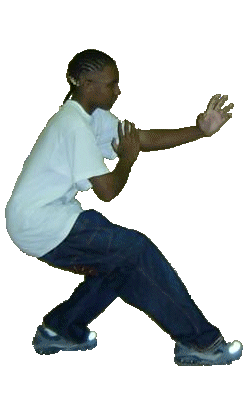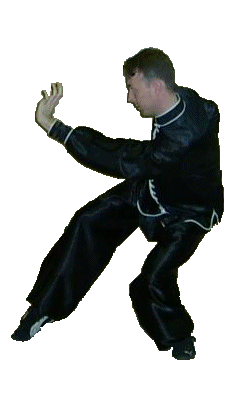
|
Hung Ga Kung Fu: back to the Roots of Southern Siulam Monastery.A comparison with Weng Shun Kuen |

|
| by Charris van ’t Slot |
Hung Ga kung fu is said to be one of the oldest and most traditional kung fu styles originating from the southern Siulam monastery.
The legends tell that the style was founded by Hung Hei Gun, who lived ca. 1745 - 1825. He was supposed to be a rebel in the Ching dynasty, that sought refugee in the southern Siulam monastery. Here he learned kung fu from the abbot Ji Sin.
When the Siulam monastery was destroyed by the Manchus, Hung Hei Gun was one of the few survivors. He ran into Fong Weng Shun, a girl that was very good in crane style. Eventually he married her and combined her crane style with his lohan and tiger style.
A southern- SiuLam style
There have always been numerous claims that Hung Ga is unchanged from the southern Siulam Monastery.
The first main set, named the Gung Ji Fuk Fu Kuen (Tame the tiger in an I-pattern) was developed by Ji Sin, the abbot of the southern Siulam Monastery.
Next to that it’s said Hung Heigun created the second main set of Hung Ga, named Fu Hok Seung Ying Kuen (Tiger & Crane Set), when he combined styles with his wife Fong Weng Shun.
Different claims
However, in recent time, more styles claim to come from Ji Sin and to be the most unchanged Siulam style. Examples of these styles are Weng Shun Kuen, Wing Chun Kuen and Yong Chun Crane style. They all claim to come from Siulam and all have lovely legends about some girl named "Weng Shun/Wing Chun" (although all styles tell it was not the same girl as in the other style).
Although Hung Heigwun and Ji Sin proabably did exist, there are hardly any facts known about them and certainly not about there kung fu.
So how can we all be so different and claim the same?
Hung Ga and Weng Shun Kuen- a comparison
One of the styles that is said to be closest to the original southern Siulam style is Weng Shun Kuen.
Weng Shun Kuen has just three sets (as all the old styles only had three sets).
Although Weng Shun Kuen shares the names of the sets of the more known versions of Wing Chun, the sets, tactics and use of power are a little different to very different. As most Wing Chun styles will block and attack centerline with an overload of punches (chain punches), Weng Shun prefers to make contact (bridge) centerline, but as soon as contact is made, the side is chosen. Another big difference is that Weng Shun Kuen contains chigong in their forms.
These are also things that still can be found in the Hung Ga style, however in Hung Ga it’s just a small part as many sets have been added.
The Hung Ga practitioner makes contact with the underarms (bridges), controls the power and counters from the side. The only difference with Wen Shun Kuen here is that Hung Ga uses hard power to cut of the attack, where Weng Shun Kuen uses soft power to guide the attacking power away.
Hung Ga uses chigong, only in just in the most advanced main set, named Tit Sin Kuen (Iron Wire).
Weapons
Another thing that Hung Ga and Weng Shun have in common is the use of butterfly knives. As the butterfly knives are originally a southern weapon, the Hung Ga butterfly knives are said to come from southern Siulam as well. The techniques of the butterfly knives of both styles are a like, except that the footwork of Hung Ga is deeper. So this again proves that both styles have the same source.
A big difference is the number of forms and techniques. Hung Ga has much more techniques, more sets and more different weapons.
Where Wing Chun Kuen only has the butterfly knives and pole and Weng Shun Kuen only has butterfly knives, pole, throwing dart and straight sword.
Hung Ga also has many northern weapons, such as broadsword, straigth sword, spear, kwando and many more.
Recent research
Recent research in the Hung Ga history shows that most Hung Ga sets aren’t that old at all.
Many sets, including the famous Tiger & Crane Set, were devised by Wong Fei Hung after 1850. And it is also suspected that the stances and fighting distance were changed by Wong Fei Hung. Wong Fei Hung made the stances deeper and included techniques for long range.
Wong Fei Hung learned many styles and the original southern style was just one of them. Wong Fei Hung combined all his knowledge and created the base of the current Hung Ga.
Before Wong Fei Hung the Hung Ga style was only a short-range style, with high stances and only 3 sets; thus resembling Weng Shun, Wing Chun and Yong Chun crane much more. In time Hung Ga was mixed with several other southern styles and northern styles though, resulting in the current Hung Ga style that is dynamic and powerful with deep, solid stances.
Note: for convenience a differatation is made between Weng Shun and Wing Chun. In Chinese they are however both spoken as wing chun, but have a different characters and meanings.
About the author:
Charris van ’t Slot is a student of Hung Ga grandmaster Lam Chun Fai.
He has done a lot of research on the history of Hung Ga and is one of the
big forces behind Hung Ga United www.hungga.net, a website devoted to the
Hung Ga System.
Next to that Charris devotes himself in spreading the Hung Ga. His school is
located in Utrecht NL, http://www.hungga.info.
|
|